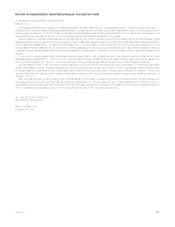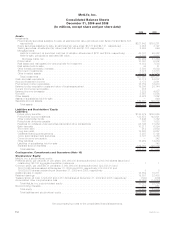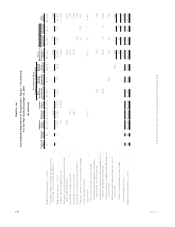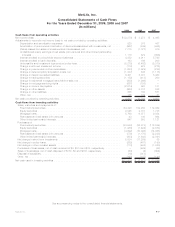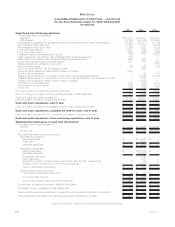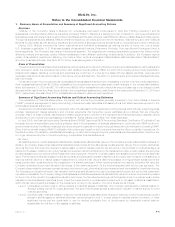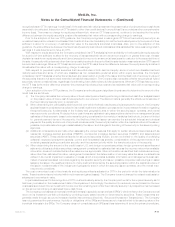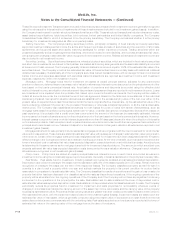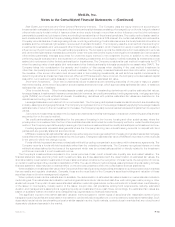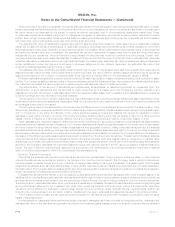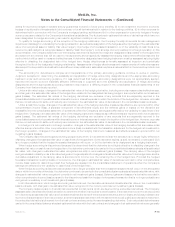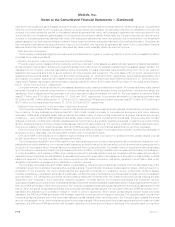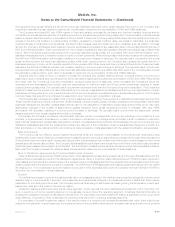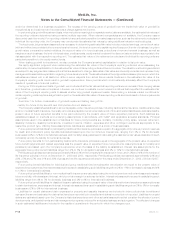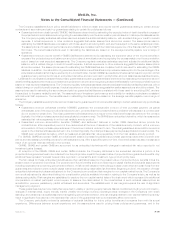MetLife 2009 Annual Report Download - page 94
Download and view the complete annual report
Please find page 94 of the 2009 MetLife annual report below. You can navigate through the pages in the report by either clicking on the pages listed below, or by using the keyword search tool below to find specific information within the annual report.Level 3 Unobservable inputs that are supported by little or no market activity and are significant to the estimated fair value of the assets or
liabilities. Unobservable inputs reflect the reporting entity’s own assumptions about the assumptions that market participants
would use in pricing the asset or liability. Level 3 assets and liabilities include financial instruments whose values are determined
using pricing models, discounted cash flow methodologies, or similar techniques, as well as instruments for which the
determination of estimated fair value requires significant management judgment or estimation.
Prior to January 1, 2009, the measurement and disclosures of fair value based on exit price excluded certain items such as nonfinancial
assets and nonfinancial liabilities initially measured at estimated fair value in a business combination, reporting units measured at estimated
fair value in the first step of a goodwill impairment test and indefinite-lived intangible assets measured at estimated fair value for impairment
assessment.
Investments
The accounting policies for the Company’s principal investments are as follows:
Fixed Maturity and Equity Securities. The Company’s fixed maturity and equity securities are classified as available-for-sale and
are reported at their estimated fair value.
Unrealized investment gains and losses on these securities are recorded as a separate component of other comprehensive income
(loss), net of policyholder related amounts and deferred income taxes. All security transactions are recorded on a trade date basis.
Investment gains and losses on sales of securities are determined on a specific identification basis.
Interest income on fixed maturity securities is recorded when earned using an effective yield method giving effect to amortization of
premiums and accretion of discounts. Dividends on equity securities are recorded when declared. These dividends and interest
income are recorded in net investment income.
Included within fixed maturity securities are loan-backed securities including mortgage-backed and asset-backed securities.
Amortization of the premium or discount from the purchase of these securities considers the estimated timing and amount of
prepayments of the underlying loans. Actual prepayment experience is periodically reviewed and effective yields are recalculated
when differences arise between the prepayments originally anticipated and the actual prepayments received and currently anticipated.
Prepayment assumptions for single class and multi-class mortgage-backed and asset-backed securities are estimated by manage-
ment using inputs obtained from third-party specialists, including broker-dealers, and based on management’s knowledge of the
current market. For credit-sensitive mortgage-backed and asset-backed securities and certain prepayment-sensitive securities, the
effective yield is recalculated on a prospective basis. For all other mortgage-backed and asset-backed securities, the effective yield is
recalculated on a retrospective basis.
The Company periodically evaluates fixed maturity and equity securities for impairment. The assessment of whether impairments
have occurred is based on management’s case-by-case evaluation of the underlying reasons for the decline in estimated fair value.
The Company’s review of its fixed maturity and equity securities for impairments includes an analysis of the total gross unrealized
losses by three categories of securities: (i) securities where the estimated fair value had declined and remained below cost or
amortized cost by less than 20%; (ii) securities where the estimated fair value had declined and remained below cost or amortized cost
by 20% or more for less than six months; and (iii) securities where the estimated fair value had declined and remained below cost or
amortized cost by 20% or more for six months or greater. An extended and severe unrealized loss position on a fixed maturity security
may not have any impact on the ability of the issuer to service all scheduled interest and principal payments and the Company’s
evaluation of recoverability of all contractual cash flows or the ability to recover an amount at least equal to its amortized cost based on
the present value of the expected future cash flows to be collected. In contrast, for certain equity securities, greater weight and
consideration are given by the Company to a decline in market value and the likelihood such market value decline will recover. See also
Note 3.
Additionally, management considers a wide range of factors about the security issuer and uses its best judgment in evaluating the
cause of the decline in the estimated fair value of the security and in assessing the prospects for near-term recovery. Inherent in
management’s evaluation of the security are assumptions and estimates about the operations of the issuer and its future earnings
potential. Considerations used by the Company in the impairment evaluation process include, but are not limited to: (i) the length of
time and the extent to which the estimated fair value has been below cost or amortized cost; (ii) the potential for impairments of
securities when the issuer is experiencing significant financial difficulties; (iii) the potential for impairments in an entire industry sector or
sub-sector; (iv) the potential for impairments in certain economically depressed geographic locations; (v) the potential for impairments
of securities where the issuer, series of issuers or industry has suffered a catastrophic type of loss or has exhausted natural resources;
(vi) with respect to fixed maturity securities, whether the Company has the intent to sell or will more likely than not be required to sell a
particular security before the decline in estimated fair value below cost or amortized cost recovers; (vii) with respect to equity
securities, whether the Company’s ability and intent to hold the security for a period of time sufficient to allow for the recovery of its
estimated fair value to an amount equal to or greater than cost; (viii) unfavorable changes in forecasted cash flows on mortgage-
backed and asset-backed securities; and (ix) other subjective factors, including concentrations and information obtained from
regulators and rating agencies.
Effective April 1, 2009, the Company prospectively adopted new guidance on the recognition and presentation of other-than-tem-
porary impairment (“OTTI”) losses as described in “Adoption of New Accounting Pronouncements — Financial Instruments.” The new
guidance requires that an OTTI be recognized in earnings for a fixed maturity security in an unrealized loss position when it is
anticipated that the amortized cost will not be recovered. In such situations, the OTTI recognized in earnings is the entire difference
between the fixed maturity security’s amortized cost and its estimated fair value only when either: (i) the Company has the intent to sell
the fixed maturity security; or (ii) it is more likely than not that the Company will be required to sell the fixed maturity security before
recovery of the decline in estimated fair value below amortized cost. If neither of these two conditions exists, the difference between
the amortized cost basis of the fixed maturity security and the present value of projected future cash flows expected to be collected is
F-10 MetLife, Inc.
MetLife, Inc.
Notes to the Consolidated Financial Statements — (Continued)



